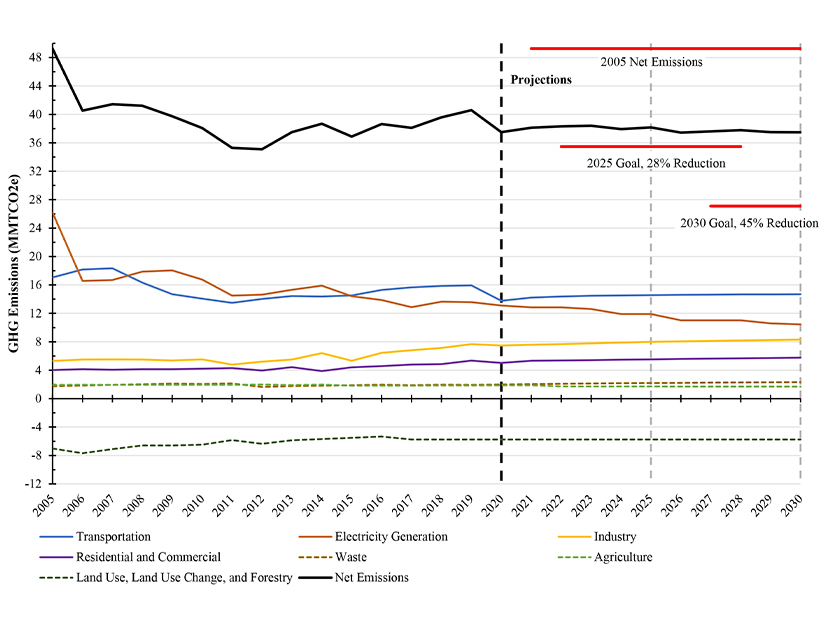
A new report from the state of Nevada projects that the state’s greenhouse gas emissions in 2030 will be 24% less than in 2005 — far short of the 45% reduction that the state has set as a goal.
And the 24% projected reduction in 2030 is only slightly more than the 23% reduction expected by 2025. Nevada’s goal for 2025 is a 28% reduction in GHG emissions compared to 2005.
The figures are included in the state’s 2021 GHG emissions inventory and projections report, which the Nevada Department of Conservation and Natural Resources (NDCNR) released last week. The 2021 report details the state’s GHG emissions through 2019 with projections through 2041.
State Senate Bill 254 requires NDCNR to issue the report each year.
The report finds that the state’s electricity sector is on track to meet the renewable portfolio standard (RPS), which requires half of energy sold to customers to come from renewable sources by 2030.
But increased emissions from the transportation, industrial, and residential and commercial sectors “cancel out” progress made under the RPS, NDCNR said.
“Additional climate action is necessary to stay on track with the goals and reign in climate pollution across all economic sectors,” NDCNR said in a release.
The report lists an array of policies Nevada could adopt to potentially bring the state closer to its GHG reduction goals. They include implementing net-zero building codes, adopting California’s upcoming Advanced Clean Cars II regulation or integrating the social cost of GHG emissions in planning.
The report noted that the listed policies aren’t recommendations at this stage; further analysis of costs and benefits is needed.
Decreased Emissions
In 2019, Nevada’s net GHG emissions totaled 40.6 million metric tons of CO2 equivalent (MMTCO2e), an 18% reduction from 49.3 million metric tons in 2005. Nevada contributed 0.71% of the U.S. total for gross GHG emissions in 2019, despite having 0.94% of the population, the report said.
Transportation overtook the electricity generation sector in 2015 to become the state’s largest source of GHG emissions. Emissions from the industrial sector are also on the rise.
In 2019, transportation contributed 34% of the state’s GHG emissions, the report said, followed by electricity generation at 29% and industry at 17%.
Given the trends for the transportation and industrial sectors, “addressing GHG emissions from these two sectors should be a priority for policymakers in both the near- and long-term,” according to the report.
“It is also important to note that continued decarbonization of the electricity generation sector is needed to realize greater carbon reduction benefits of transportation sector electrification,” the report said.
Transportation Sector
GHG emissions from Nevada’s transportation sector hit a low of 13.5 MMTCO2e in 2011, but by 2019 had increased by about 18%. Highway vehicles and aircraft were the main drivers of the increase, the report said.
The report predicts that 2020 data will show a drop in transportation sector emissions, followed by a gradual increase through 2041.
“Generally, gains in emission reductions due to new federal and state regulations will be offset by population and economic growth,” the report said.
But NDCNR noted the “high degree of uncertainty” in making GHG projections for the sector. In particular, it’s not yet known how long the increase in teleworking seen during the COVID-19 pandemic will continue.
In October, the state adopted the Clean Cars Nevada program, which takes effect starting with model year 2025 vehicles. (See Nev. Adopts Clean Cars Rule, Allows Early Credits.)
The report noted that it will take several years for the program to start making a dent in GHG emissions. By 2041, transportation sector emissions are expected to be about 6% lower than they would have been in the absence of the program.
Electricity Sector
GHG emissions from the electricity generation sector dropped from 26.2 MMTCO2e in 2005 to 13.6 million metric tons in 2019, a 48% reduction. The report estimates emissions for all fossil fuel-fired electricity generated in Nevada, even though some of that electricity may be used out of state.
The report attributes the sector’s decrease in GHG emissions largely to the retirement of the Mohave Generating Station in 2005 and the Reid Gardner Generating Station’s last unit in 2017. The two coal-fired power plants were partially replaced with natural gas-fired plants. The increased use of renewable energy is another factor in the sector’s GHG reductions, the report said.
Nevada has two remaining coal-fired power plants: the North Valmy Generating Station, which could potentially retire in 2025; and TS Power, which is expected to be converted to a dual coal and natural gas plant.
The report projects that those changes will contribute to a reduction in emissions from the electricity sector to 8 million metric tons in 2041.



